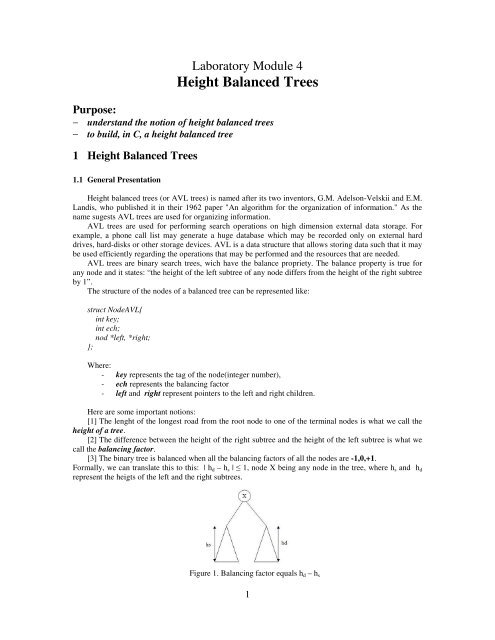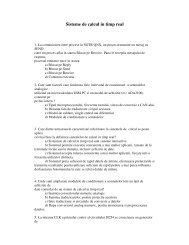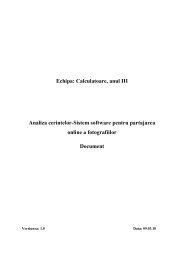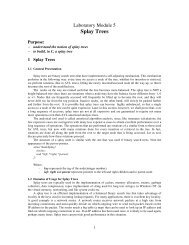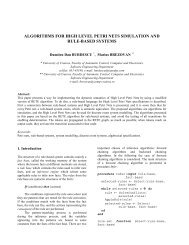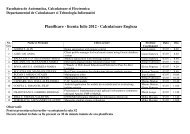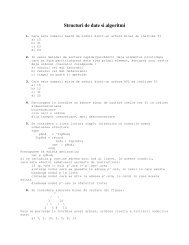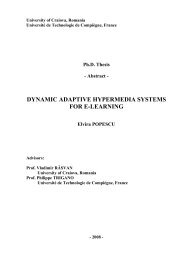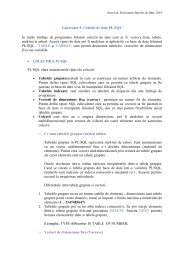Create successful ePaper yourself
Turn your PDF publications into a flip-book with our unique Google optimized e-Paper software.
Laboratory Module 4<br />
<strong>Height</strong> <strong>Balanced</strong> <strong>Trees</strong><br />
Purpose:<br />
− understand the notion of height balanced trees<br />
− to build, in C, a height balanced tree<br />
1 <strong>Height</strong> <strong>Balanced</strong> <strong>Trees</strong><br />
1.1 General Presentation<br />
<strong>Height</strong> balanced trees (or AVL trees) is named after its two inventors, G.M. Adelson-Velskii and E.M.<br />
Landis, who published it in their 1962 paper "An algorithm for the organization of information." As the<br />
name sugests AVL trees are used for organizing information.<br />
AVL trees are used for performing search operations on high dimension external data storage. For<br />
example, a phone call list may generate a huge database which may be recorded only on external hard<br />
drives, hard-disks or other storage devices. AVL is a data structure that allows storing data such that it may<br />
be used efficiently regarding the operations that may be performed and the resources that are needed.<br />
AVL trees are binary search trees, wich have the balance propriety. The balance property is true for<br />
any node and it states: “the height of the left subtree of any node differs from the height of the right subtree<br />
by 1”.<br />
The structure of the nodes of a balanced tree can be represented like:<br />
struct NodeAVL{<br />
int key;<br />
int ech;<br />
nod *left, *right;<br />
};<br />
Where:<br />
- key represents the tag of the node(integer number),<br />
- ech represents the balancing factor<br />
- left and right represent pointers to the left and right children.<br />
Here are some important notions:<br />
[1] The lenght of the longest road from the root node to one of the terminal nodes is what we call the<br />
height of a tree.<br />
[2] The difference between the height of the right subtree and the height of the left subtree is what we<br />
call the balancing factor.<br />
[3] The binary tree is balanced when all the balancing factors of all the nodes are -1,0,+1.<br />
Formally, we can translate this to this: | h d – h s | ≤ 1, node X being any node in the tree, where h s and h d<br />
represent the heigts of the left and the right subtrees.<br />
Figure 1. Balancing factor equals h d – h s<br />
1
Figure 2. Binary search tree with computed baancing facors<br />
Here are some xxamples of procedures for the calculus of the height of a subtree and of the balancing<br />
factor for the above binary search tree.<br />
- the height of the tree is 4, meaning the lenght of the longest path from the root to a leaf node.<br />
- the height of the left subtree of the root is 3, meaning that the lenght of the lognest path from the<br />
node 13 to one of the leaf nodes (2, 7 or 12).<br />
-for finding the balancing factor of the root we substract the height of the right subtree and the left<br />
subtree : 1-3 = - 2.<br />
-the balancing factor of the node with the key 12 is very easy to determine.We notice that the node has<br />
no children so the balancing factor is 0.<br />
-for finding the balancing factor of the node with key 5 we substract the height of the right subtree<br />
from the height of the left subtree: 1 - 0 = +1.<br />
We present below the function drum, wich calculates the lognest road frome the current node ,<br />
meaning the height of a subtree:<br />
void path(NodeAVL* p,int &max, int length){<br />
if (p!=NULL){<br />
path(p->right,max,length+1);<br />
if ((p->left==NULL)&&(p->right==NULL)&&(maxleft,max,length+1);<br />
}<br />
}<br />
Using this function we can determine the balancing indicatior of each node of the tree with the<br />
function balanceFactor:<br />
void balanceFactor(NodeAVL *p){<br />
int max1,max2;<br />
max1=1; max2=1;<br />
if(p->left!=NULL)<br />
path(p->left,max1,1);<br />
else<br />
max1=0;<br />
if(p->right!=NULL)<br />
2
}<br />
path(p->right,max2,1);<br />
else<br />
max2=0;<br />
p->ech=max2-max1;<br />
1.2 Operations on AVL <strong>Trees</strong><br />
1.2.1 Insertion into AVL <strong>Trees</strong><br />
An insertion into the tree can lead to the umbalance of some nodes wich occurs in the case of the<br />
formula: |h d – h s | ≤ 1 not being respected.<br />
Basically, a key is inserted like in an ordinary binary search tree, meaning that we start from the root<br />
following the left or right nodes according to the relation between the key we insert and the key of the<br />
nodes we are passing, untill we reach a node which can become parent of the new node. After insertion we<br />
go recursively upwords and we search the first node that is not balanced, meaning the first node whose<br />
subtrees heights difference differ by 2 units. This node must be balanced and will be in 1 of the 4 cases<br />
wich follow.<br />
Case 1. Simple right rotate<br />
Case 2. Simple left rotate<br />
Figure 3. Simple right rotate<br />
Figure 4. Simple left rotate<br />
3
Case 3. Double right rotate<br />
Figure 5. Double right rotate<br />
4
Case 4. Double left rotate<br />
Figure 6. Double left rotate<br />
Here is an example of building an AVL tree by inserting keys 4, 5, 7, 2, 1, 3, 6. We start from an<br />
empty tree.<br />
INSERT KEYS 4 and 5<br />
The nodes with the keys 4 and 5 will be inserted like in the binary search trees. Since we do not have<br />
balance factor greater than 1 no rotation is needed.<br />
INSERT KEY 7<br />
The node with the 7 key should be inserted in the right of the node with the key 5. In this case the tree<br />
is umbalanced since the balance factor of root node becomes 2. Figure 7 presents the simple left rotation<br />
that is performed the the final shape of the tree.<br />
5
Figure 7. Simple left rotation for root node<br />
INSERT KEY 2<br />
The node with the 2 key will be inserted at the left of the node with the 4 key without the tree<br />
becoming umbalanced.<br />
INSERT KEY 1<br />
The node with the 1 key will be inserted at the left of the node with the key 2, but in this case the tree<br />
is unbalanced because key 4 has balance factor -2. Figure 8 presents the simple right rotation that is<br />
performed the the final shape of the tree.<br />
Figure 8. Simple right rotation for node with key 4<br />
INSERT KEY 3<br />
The node with the 3 key will be inserted at the left of the node with the key 4, but in this case the tree<br />
is unbalanced because key 5 has balance factor -2. Figure 9 presents the double right rotation that is<br />
performed the the final shape of the tree.<br />
INSERT KEY 6<br />
The node with the 6 key will be inserted at the left of the node with the key 7, but in this case the tree<br />
is unbalanced because key 5 has balance factor +2. Figure 10 presents the double left rotation that is<br />
performed the the final shape of the tree.<br />
6
Figure 9. Double right rotation for node with key 5<br />
Figure 10. Double left rotation for node with key 5<br />
7
The insert function is below:<br />
NodeAVL* insert(NodeAVL *p, int x){<br />
if(p==NULL){<br />
// if the current node is NULL then<br />
p=new NodeAVL; // allocate space for it in the heap area<br />
p->key=x;<br />
// the information becomes x<br />
p->ech=0;<br />
// the factor balance is 0 - the node is balanced<br />
p->right=NULL; // the node is inserted as a leaf node<br />
p->left=NULL; // so that its children are referenced NULL<br />
return p;<br />
}else<br />
if (xkey)<br />
// if the key that wish to be inserted is smaller than the information value of the current node<br />
p->left = insert(p->left,x);<br />
// then is inserted into the current node's left subtree<br />
else<br />
if (x>p->key)<br />
// if the key that wish to be inserted is greater than the information value of the current node<br />
p ->right = insert(p->right,x);<br />
// then is inserted //into the current node's rigt subtree<br />
else<br />
coutech==2){ // if p is a critical node with balance facor +2<br />
w=p->right;<br />
// then w is the right child of p<br />
if (w->ech==-1) // and if it has a balance factor of -1<br />
p = d_rot_left(p); // then is made a double left rotation<br />
else<br />
// otherwise a simple left rotation<br />
p = left_rot(p);<br />
}<br />
return p;<br />
8
1.2.2 Deletion from AVL <strong>Trees</strong><br />
Deletion from AVL trees may be treated as deletion of a node for which left or right pointer are<br />
NULL. From this point of view the procedure is similar with deletion of nodes from a binary search tree.<br />
The difference consists in the fact that the path from the root node to the node that is to be deleted needs ro<br />
be recorded. The steps necessary for deleting nodes from an AVL tree are:<br />
Step1. Find the node that needs to be deleted. The path from root node to deleted node needs to be<br />
recorded.<br />
Step2. Find the predecessor/successor of the deleted node. This path needs also to be recorded.<br />
Step3. Replace the key of the deleted node with the key of the predecessor/successor. At successor<br />
level make the proper indirections (same as in a binary search tree).<br />
Step4. Update the balance factors on the backward path from the predecessor/successor node<br />
involved in deletion at step 3 to the root node. When necessary perform rotations.<br />
Let us suppose we have an AVL tree as the one in the next figure where node with key 12 needs to<br />
be deleted.<br />
Figure 11. Deletion of node with key 12 – initial situation<br />
Figure 12. Deletion of node with key 12 – after replacing key 12 with key 15<br />
9
The node with key 15 (the successor for the node with key 12) has replaced the key 12. After this<br />
operation is performed, the balance factor of node with key 20 becomes 0 and the balance factor of node<br />
with key 15 becomes -2. This means a rebalancing procedure for node 15 is necessary. Since node 15 has<br />
balance factor -2 and the left child (node with key 8) has balance factor of +1 a double right rotation for<br />
node 15 is necessary. After this rotation the tree will look like in the next figure. The balance factor of node<br />
with key 24 is also increased thus becoming 0.<br />
Figure 13. Deletion of node with key 12 – final shape, after rebalancing<br />
The deletion function is the following:<br />
NodeAVL* deletion(NodeAVL *p,int x){<br />
NodeAVL *q,*r,*w;<br />
if (p!=NULL)<br />
// if the current node is not NULL then<br />
if (xkey)<br />
// the key that wish to be removed is less than the node information<br />
p->left = deletion(p->left,x);<br />
// the key is searches in the left subtree of current the node<br />
else<br />
if (x>p->key)<br />
// if the key is greater<br />
p->right = deletion(p->right,x);// searches in the right subtree<br />
else{<br />
// if the key is equal with the information from the current node<br />
q=p;<br />
// a node q becomes p<br />
if (q->right==NULL) // if q's right child is NULL<br />
p=q->left; // then p becomes q->stanga<br />
else<br />
if (q->left==NULL) // if q's left child is NULL<br />
p=q->right; // p becomes q->dreapta<br />
else{<br />
w=q->left; // else w is q's left child<br />
r=q;<br />
// r becomes q<br />
if (w->right!=NULL) { //if w's right child is not NULL<br />
while (w->right!=NULL){<br />
r=w;<br />
w=w->right;<br />
}<br />
p->key=w->key;<br />
q=w;<br />
r->right=w->left;<br />
10
}<br />
}<br />
if (p!=NULL)<br />
}<br />
}<br />
delete(q);<br />
p = balance(p);<br />
return p;<br />
}<br />
else{<br />
r=p->left;<br />
w=w->left;<br />
if (r!=NULL)<br />
while ((r!=w)&&(r!=NULL)){<br />
r = balance(r);<br />
r=r->right;<br />
}<br />
p->key=w->key;<br />
p->left=w->left;<br />
q=w;<br />
// q is deleted<br />
// p is balanced if is not NULL<br />
2. Assignments<br />
1) Write a program that creates and manages an AVL tree. The program must implement the following<br />
operations: creation, insertion, deletion, update and tree display. The program should present a meniu<br />
where user may choose from implemented options.<br />
2) It is given the AVL tree from the following figure.<br />
Present the shape of the tree after each of the following operations:<br />
- INSERT 3<br />
- INSERT 24<br />
- INSERT 27<br />
- INSERT 37<br />
- DELETE 31<br />
- DELETE 25<br />
-<br />
For each insertion operation there must be presented the following:<br />
- Initial position of the key into the AVL tree<br />
- The updated balance factors<br />
- The critical nodes, with balance factor different from -1, 0 or 1<br />
- The rotation type that needs to be performed and how the rotation will perform<br />
- The final shape of the tree<br />
For each deletion operation there must be presented the following:<br />
- The search of the tree for the key that needs to be deleted<br />
- The identification of the predecessor/successor key<br />
11
- The replacement of the deleted key with predecessor/successor key and the proper pointer<br />
indirection at predecessor/successor level<br />
- The updated balance factors<br />
- The critical nodes, with balance factor different from -1, 0 or 1<br />
- The rotation type that needs to be performed and how the rotation will perform<br />
- The final shape of the tree<br />
References:<br />
Adelson-Velskii, G.; E. M. Landis (1962). "An algorithm for the organization of information". Proceedings<br />
of the USSR Academy of Sciences 146: 263–266. (Russian) English translation by Myron J. Ricci in<br />
Soviet Math. Doklady, 3:1259–1263, 1962.<br />
12


